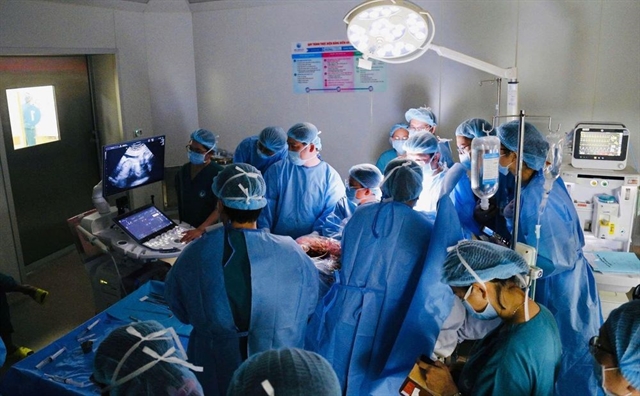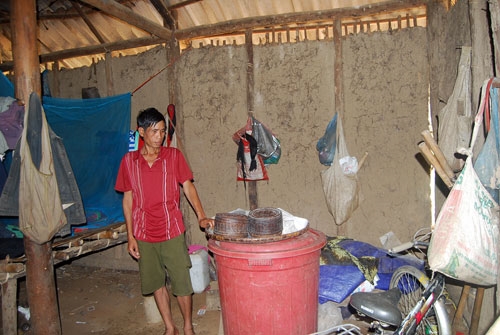 Society
Society

A steep increase in the number of poor and near-poor households following the implementation of new poverty measuring standards is putting pressure on the Government to achieve its poverty eradication goals.
 |
| A poor household in Pá Bông, Điện Biên District, Điện Biên Province. – Photo danviet.vn |
HÀ NỘI – A steep increase in the number of poor and near-poor households following the implementation of new poverty measuring standards is putting pressure on the Government to achieve its poverty eradication goals.
Located some 400km to the northwest of Hà Nội, the mountainous border district of Yên Minh in Hà Giang Province last year saw the average number of poor households climb to more than 61 per cent after authorities applied the new multi-dimensional poverty measure.
It was a 2.5 times surge compared to only some 24.5 per cent the same time last year when calculated using the older method, Yên Minh Labour Division Head Nguyễn Văn Đỉnh told the Nông thôn ngày nay newspaper.
“There are some communes, for example Sùng Tráng, that now have more than 80 per cent of local households listed as poor,” he said.
The upwards trend has also occurred in Mường Nhé District in northwestern Điện Biên Province, as the figure has increased by 1.5 times since applying the new multidimensional poverty measure. The district’s poverty rate spiked from 45 per cent in 2014 to 74 per cent last year because of different measuring methods. In 2011 the poverty rate (under the old measurement system) was 77.8 per cent.
Việt Nam last year asked localities to apply the multidimensional poverty measure that considers whether a household is poor or not based on its income and five other basic criteria including access to medical services, education, accommodation, as well as clean water and hygiene and information services.
Such a complicated and multi-faceted measurement in lieu of the older way of calculating poverty purely by household income led to a sharp hike in the number of households recorded as poor and near-poor.
Statistics from the Ministry of Labour, Invalids and Social Affairs (MoLISA) show that the multidimensional measurement had the national poverty rate in 2015 triple to about 15 per cent compared to the previous measurement technique.
Budget sufficiency
The National Assembly last November passed the five-year national programme on sustainable poverty reduction 2016-2020, aiming to bring down the average national poverty rate by one to 1.5 per cent annually, and up to 4 per cent in extremely disadvantaged areas.
The Government planned to pour at least VNĐ46.1 trillion (US$2.06 billion) into the national programme, a 30 per cent increase to the same programme for the last five-year period of 2012-2015.
Yet local officials in those areas, disproportionately located in remote mountainous regions where a majority of residents are ethnic minorities, were growing anxious about whether they could accomplish the newly set targets with as yet no actual money flowing through other than the rhetorical announcements of an increased amount invested.
Đoọc Mạy Commune in the central province of Nghệ An had 68 per cent of its population considered as poor by the multidimensional measure, a rise of 18 per cent compared to 2014.
The communal People’s Committee Chairman Lỳ Giống Dìa said that he struggled every year to figure out how to divide the limited budget support to such a large pool of households in need.
“There is the 30A programme providing cattle to help poor households that gave us officials a headache whenever the cows came,” he said.
“There were times when we had to hold three or four resident meetings yet still failed to decide who got to raise the cows. How are we supposed to reduce poverty with such little support but so many poor people?”
Yên Minh District Labour Division Head Nguyễn Văn Đỉnh said his biggest concern was whether the budget would be enough to lift villagers out of the newly applied poverty scale.
“Apart from economic support, investment in education, medical services, clean water and information connections should all be prioritised,” he said.
MoLISA Deputy Minister Nguyễn Trọng Đàm said that the Government was not too surprised at the poverty rate surge, believing it could handle the funding pressures to accomplish the national programme targets.
“The rate (of poverty) is actually three per cent lower than the initial predictions made by MoLISA and the General Statistics Office,” he said.
Đàm said that Việt Nam previously had managed to find sufficient resources to cut the initial poverty rate of 14.2 per cent in 2011 down to less than 5 per cent last year.
“The increased rate (15 per cent) still hovers around the initial level so there should be enough resources to fund poverty reduction plans,” he said.
He also said the Government was working to review and cut overlapping support policies and programmes to spend the budget more efficiently.
“The kind of programmes that ‘give a man a fish’ will be eliminated and in their place there will be policies to encourage the poor to work their way up themselves,” he said.
The Ministry of Finance was still on its way to map out a national budget distribution plan in line with the poverty reduction programme while the Committee on Ethnic Minority Affairs was rushing to complete a criteria set on categorising extremely disadvantaged localities to focus support on, of which the deadline to submit to the Prime Minister for approval is this September. – VNS




